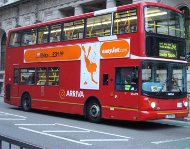11/3/2011
UK: Buses Emit More Pollutants Than AutomobilesUK government data suggest automobiles may be more environmentally friendly than transit buses.

Advocates of diverting tax money raised from motorists on mass transit insist doing so is essential for protecting the environment. Data published in August by the UK Department for Environment, Food and Rural Affairs (DEFRA) show that buses outside London produced an average of 221 grams per passenger kilometer of greenhouse gas emissions. This is more than the figure given for small gasoline-powered cars, 210. Small and medium diesel-powered cars also beat the bus with scores of 172 and 215.
"Perhaps those who criticize lone car drivers should turn their attention to empty off-peak buses instead," Association of British Drivers environment spokesman Paul Biggs said in a statement. "Although buses provide an important public service, even London can only manage an average occupancy of around fifteen passengers. Modern efficient cars outperform buses not just for CO2 emissions, but for genuine pollutants as well."
Greenhouse gas emission figures represent the output of carbon dioxide -- the harmless gas emitted by all human beings as an essential part of the respiratory process -- combined with nitrous oxide and methane. Government official in the UK and US maintain these substances are causing global warming.
DEFRA's bus figures are based on actual fuel consumption by bus operators and ridership data. It is consistent with figures obtained from a 1999 test by the Los Angeles, California Metropolitan Transportation Authority (MTA). Diesel bus engines were tested on a central business district route simulation burning fuel at a rate of 4 miles per gallon with carbon dioxide emissions of 2571 grams per mile or 1597 grams per kilometer. Assuming the bus carries nine passengers on average, the carbon dioxide emissions were 174 grams per passenger kilometer (DEFRA's figure was 184). A solo driver can beat that figure in a Toyota Yaris at 127, a Honda Civic diesel at 140. Even a large SUV like the Porsche Cayenne achieves a solo figure of 236, but with an average occupancy of 1.6 the Porsche still beats the per-passenger figure of the bus.
A March 2009 report by Transport and Travel Research Ltd found that on a per passenger kilometer basis, bus travel produced more particulate matter and other pollutants than automobiles.
"This report confirms that traveling by car is 'greener' than traveling by bus," Biggs said on the report's release. "Bus companies will have to invest heavily in fleet modernization and the retrofitting of emission abatement technology to even stand a chance of keeping up with increasingly cleaner cars. This is a 'wake up' call to politicians who persist with the transport and environmental mantras of, 'The answer's a bus, now what's the question?' Given that buses and coaches carry only 6.3 percent of passengers compared to the 86.5 percent who travel by car, van or taxi, should 6 percent of passengers be given up to 50 percent of the road via bus lanes?"
A copy of the DEFRA conversion report is available in a 1.8mb PDF file at the source link below.


